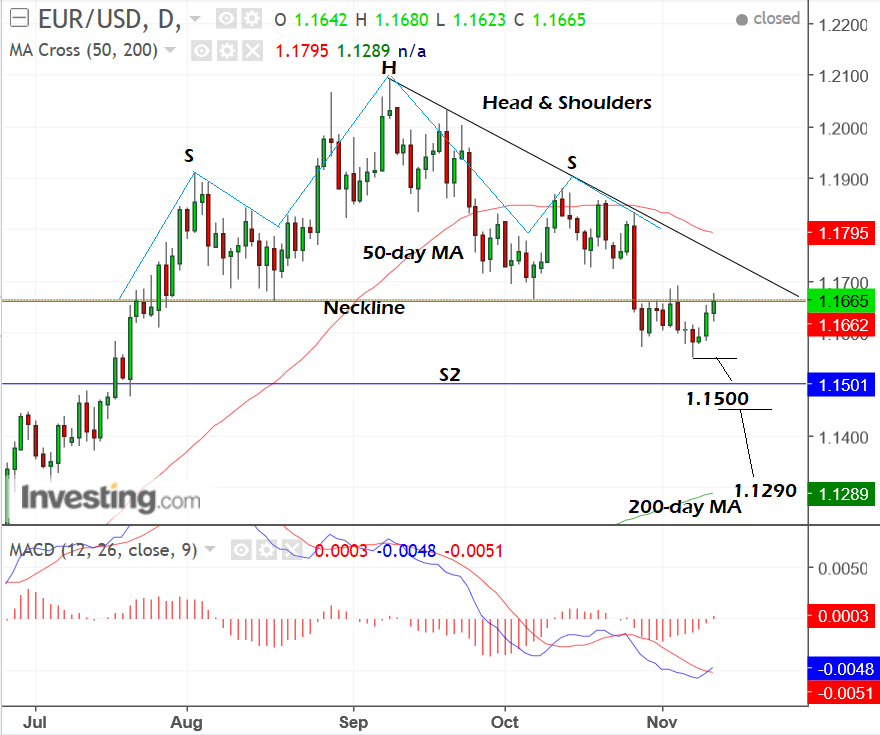Euro-to-Dollar Rate Week Ahead: Technical Forecast, Events and Data to Watch

The EUR/USD is looking more assured at the start of the new week after a recovery at the end of the previous week brought into question the validity of a bearish pattern on the chart.
The analysis of price-action plotted on price charts is called technical analysis and it is widely used throughout finance to forecast asset price moves.
Technical analysis theory posits that there are patterns within price action on charts which repeat in a predictable fashion and therefore enable forecasters to accurately predict the future direction of prices.
One such pattern has formed on the chart of Euro-to-Dollar exchange rate's chart between July and October, during the time when the market peaked at 1.2094 on September 8.
This pattern is called a head and shoulders top (H&S) and has bearish connotations.
The H&S is formed of three peaks, the middle one of which is the tallest and represents the 'head' and the two either side, which are slightly lower, representing the 'shoulders' - thus forming the distinctive outline of a head & shoulders from which the pattern gets its name.
The H&S is a bearish reversal pattern, with a break below the neckline at the level of the two intervening troughs (see chart), providing bearish confirmation and downside equaling the height of the pattern at its tallest extrapolated lower.
Yet on the H&S which has formed on EUR/USD appears problematic.

Although the exchange rate broke below the neckline it failed to follow-through lower and instead appears to have recovered.
The reversal back higher may signal that the pattern is a fake but at the moment it is too early to be sure.
Only a break above the trendline (black line) drawn from the peak over the right shoulder would confirm the pattern was a fake, and probably lead to a strong rally in the process.
Confirmation of such a break would probably come from a move above 1.1760.
Until that happens, however, our forecast remains bearishly biased and the H&S hypothesis still stands.
We see a break below the recent 1.1554 lows probably leading to a move down to a target at 1.1500 initially where the S1 monthly pivot is situated and likely to provide an obstacle to further selling.
Monthly pivots are levels watched by traders to gauge how 'stretched' prices have become in one direction or another, however, they also perform the role of support or resistance levels like moving averages and when price action reaches them it often pulls-back, bounces or reverses the trend.
This is due to traders clustering orders around them which intensifies supply or demand within a few points of them.
The pair will probably successfully break below the pivot, however, and move lower, with a break below the 1.1450 level leading to an extension down to a target at 1.1290, which is at the level of the 200-day moving average (MA) and is commensurate with the target generated using the height of the pattern as a guide.
Data and Events to Watch for the Euro
The main focus for Euro traders in the week ahead will probably be a speech by European Central Bank (ECB) President Mario Draghi on Tuesday, November 14 at 11.00 GMT.
His views on monetary policy will come under scrutiny.
Draghi has been hitherto cagey about when he sees the ECB ending its stimulus programme and starting to raise interest rates.
But a string of positive economic releases in the week before, and rumblings of dissent from a splinter group within the ECB who wish to see monetary policy 'normalised' - which means stimulus was withdrawn and interest rates raised more quickly - may have impacted on his views and if he puts forward more concrete proposals for the timing of policy changes the Euro could rally.
The other main event for the shared-currency will be the release of the ZEW investor sentiment survey at 10.00 on Tuesday which is expected to see a small rise but is an important leading indicator for the economy.
Both the Eurozone Q3 GDP and CPI releases in the week ahead are second and final estimates respectively, which means they may only present revisions of the original first estimates which have already been released - thus the reaction to them is likely to be muted.
Get up to 5% more foreign exchange by using a specialist provider by getting closer to the real market rate and avoid the gaping spreads charged by your bank for international payments. Learn more here.
Data and Events to Watch for the Dollar
The main focus for Dollar traders in the week ahead will be a mixture of continual reassessment of how well Trump's tax reforms are moving towards becoming enshrined in law - if ever - and hard data.
Currently, tax reforms are at an early stage of development, with a blueprint released by the ways and means committee in the week before which is now the subject of significant revision and amendment by various Republican groups in Congress and the Senate.
In the week ahead the debate about whether the reforms are likely to see the light of day could be central to the Dollar's price action.
The more likely the reforms are to be approved the higher the Dollar will go because they carry the assumption that lower taxes, especially corporate ones will spur economic growth which will make the Fed raise interest rates more quickly and currencies tend to rise with interest rates.
Why do currencies rise with interest rates? Because higher interest rates attract more inflows of foreign capital drawn by the promise of higher interest returns.
The inflows need to be exchanged into the home currency which increases demand for it, raising its value.
The main sticking points around tax reforms are that the country cannot afford them because it already has 20 trillion of debt, that the rich will get richer as a result of the reforms - losing the support of house democrats - and that the money won't, in fact, lead to greater growth as companies will spend it on share-buybacks rather than investment.
According to Mark Warner, Democrat Senator for Virgina, the bill will have difficulty getting passed unless the Republicans go bi-partisan, which means involving Democrats in the drafting.
He notes how the only time major legislation has successfully been passed is via a bi-partisan approach, and put the failure of the repeal of Obamacare and other Trump policy initiatives down to the Republicans going it alone.
Although there may be a vote in Congress on the bill as soon as this week, it is the vote by the Senate which is important and that won't happen for a while.
Nevertheless, any news that indicates a bi-partisan approach could lead to significant upside for the Dollar.
For tax reform, the road ahead is long and hard but it should get there, says BK Asset Management Managing Director and FX market guru Kathy Lien.
"Its still a long road ahead that will be marked by both setbacks and progress but at the end of the day, we believe that tax reform will be achieved and when that happens we will see a nice near-term rally in the greenback," said Lien.
Hard Data
Hard data out in the week ahead for the Dollar includes Producer Price Inflation (PPI), or factory gate prices, out at 13.30 GMT on Tuesday, November 14.
PPI is often a good forward indicator for consumer prices because inflationary pressures are often felt in the factory before the high-street.
Higher inflation is more likely to lead the Federal Reserve to put up interest rates, leading to a stronger Dollar.
US consumer inflation (CPI), both headline and Core are out at 13.30 on Wednesday, with Core forecast to rise to 0.2% from 0.1% in October on a monthly basis, but the headline to slow to 0.1% from 0.5%.
The headline is forecast to fall to 2.0% year-on-year from 2.2% in October 2016 and remain unchanged at 1.7%.
Retail Sales is out at the same time as CPI and is forecast to slow to 0.1% from 1.6% on a monthly basis.
Another key release, the Philidelphia fed Manufacturing Index, is out on Thursday at 13.30 and is forecast to fall 24.1 from 27.9 in November.





